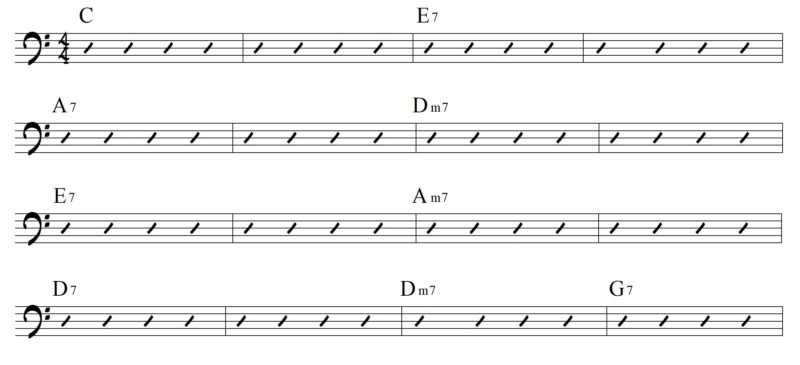This week we’re going to take a look at some basic aspects of jazz harmony in the shape of Secondary Dominant Chords
What You Need To Know…
I’m going to assume two things before we start this lesson
- A basic knowledge of chords and chord construction
- A knowledge of the basic diatonic chords in a major key
If you don’t understand anything of this, here are some lessons to get you started…
Triad Chord Construction
Seventh Chords
Chords In A Major Key
Bass Chords
What Is A Dominant Chord?
So what is a dominant chord? You may think it means Dominant 7 chord and that’s partly true but there’s a little more to it than that.
If we take a major scale like C major and number all of those notes 1 to 7 we have the following
- C = 1
- D = 2
- E = 3
- F = 4
- G = 5
- A = 6
- B = 7
These are Scale Degrees. C is the 1st, G is the 5th etc.
But… these scale degrees also have traditional names as follows:
- 1st = Tonic
- 2nd = Supertonic
- 3rd = Mediant
- 4th = Subdominant
- 5th = Dominant
- 6th = Submediant
- 7th = Leading Tone
So in the key of C Major, C is the Tonic, G is the Dominant etc.
The Dominant 7 Chord
As you might have guessed, this is why we call the dominant 7 chord the ‘dominant’ 7 chord.
When we build a seventh chord on the 5th degree of a major key we find the intervals of a root note, a major 3rd, a perfect 5th and a minor 7th. In C major this is the chord of G7:

That chord of a major triad with a flattened 7th only appears on that 5th degree of the key.
The Perfect Cadence
There is a very special relationship between the chords on the tonic and dominant degrees. The dominant to tonic chord progression is called a Perfect Cadence and it’s the most common cadence in western music. A cadence is a progression signalling the end of a phrase, section or piece.
In the key of C major, the perfect cadence would be G7 to C
There are other types of cadence but chord 5 to 1 has a huge amount of tension and resolution and a lot of that is down to the major 3rd in that chord 5.
The third of a G7 chord is B and when we look at that B relative to the whole key we find the leading note (the seventh).
If you want to hear the tension of the leading tone, just play up through a major scale and hold on the seventh. You’ll feel that need to resolve to the tonic.
What Is A Secondary Dominant Chord?
A Secondary Dominant chord is a Dominant 7 chord built on any scale degree other than the 5th. So in the key of C major: C7, D7, E7, F7, A7 and B7 would all be secondary dominant chords.
But why would we use secondary dominants? Well, that’s where that 5 to 1 perfect cadence comes into play.
As we’ve seen, the dominant chord leads nicely into the tonic chord. So a secondary dominant can be used to give a strong pull into another chord as if it were a tonic.
Let’s look at a simple example. A basic 1-6-2-5 progression in C major: Cmaj7 – Am7 – Dm7 – G7

Next let’s transform our Am7 to the secondary dominant A7:

We can also transform the Dm7 to D7

Or how about we transform both chords:

All Of Me
Secondary Dominant chords are incredibly popular in all forms of western music and especially in jazz standards. Here we have the changes to All Of Me:

The chords can be analysed as follows:
- C = Chord I
- E7 = Chord III Secondary Dominant
- A7 = Chord VI Secondary Dominant
- Dm7 = Chord ii
- Am7 = Chord vi
- D7 = Chord II Secondary Dominant
- G7 = Chord V
Triad Secondary Dominants
Bear in mind you don’t always need to have a dominant 7 chords to imply a secondary dominant function. We can do the same thing with triads by changing a minor triad to a major.
So our 1-6-2-5 progression could be written in triads as: C – Am – Dm – G
We can transform the A minor and D minor to A major and D major to create secondary dominant chords:
- C – A – Dm – G
- C – Am – D – G
- C – A – D – G
Triads don’t give as strong a secondary dominant feel as the 7th chords but the function is still secondary dominant in nature. This can be confusing to some people when analysing chord progressions especially in some pop tunes. A major triad might appear where you expect to see a minor and it’s sometimes a result of creating that dominant to tonic pull.













Thanks Mark…
A truly enlightening lesson, clearly presented with all the right explanations for exactly why this works. I couldn’t have discovered this at a better time.
Thank you SO much… T
An excellent lesson, Mark, clearly and logically delivered, on the elements of harmony. Many thanks.
This information is extremely good